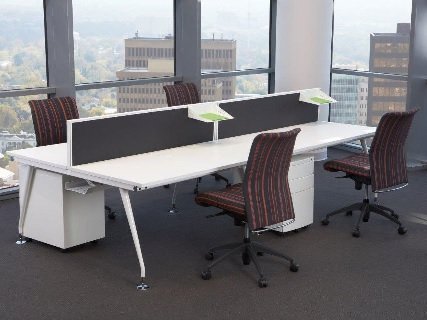Selecting the right office workstations is an essential part of creating a productive and aesthetically pleasing workspace. Office workstations serve as the foundation of your work environment, and they need to blend seamlessly with the overall office furniture style. Whether you’re redesigning your home office or setting up a commercial space, it’s important to balance functionality with style. Here’s a guide to help you choose office workstations that complement your office furniture while meeting the needs of your space.
Define Your Office Style
Before selecting office workstations, it’s crucial to define the overall style of your office furniture. Are you going for a modern, minimalist look, or do you prefer something more traditional or industrial? The style of your workstations should harmonize with your existing furniture, from desks and chairs to storage units. If you already have a cohesive look in mind, ensure that the workstations align with that aesthetic.
For modern offices, sleek designs with clean lines, neutral colors, and minimal clutter work well. On the other hand, traditional offices often feature wooden finishes, rich textures, and a more formal layout. Whatever the style, consistency between workstations and other office furniture creates a unified and polished environment.
Consider the Functionality of the Workstations
While style is important, the functionality of your workstations should take center stage when making your selection. The workstations need to accommodate the tasks your employees perform daily, from individual desks for focused work to larger, shared spaces for collaboration.
Evaluate the specific needs of your workforce—do they require ample surface space for multiple monitors and paperwork, or are they more mobile and need compact, flexible stations? Adjustable workstations that allow for sitting and standing can also be a valuable addition to any modern office, offering both health benefits and functional versatility.
Match Workstation Materials to Your Office Furniture
The materials used in your office workstations should complement those found in your existing office furniture. If your office features wooden desks, consider choosing workstations with similar wood finishes for a cohesive look. For offices with a more industrial vibe, metal or glass workstations might be a better fit.
Durability is another factor to consider when selecting materials. Choose workstations made from high-quality, long-lasting materials that can withstand everyday wear and tear. Look for options that provide both visual appeal and durability, such as laminate finishes for desks or tempered glass for a modern touch.
Choose the Right Color Scheme
Color plays a significant role in how cohesive and aesthetically pleasing your office feels. When choosing workstations, think about the color scheme of your existing office furniture and decor. The goal is to create a harmonious color palette throughout the office.
For example, if your office furniture is mostly neutral with shades of gray, white, or beige, choose workstations in similar tones. If you want to add a pop of color, opt for accent chairs, divider panels, or office accessories that can bring vibrancy without overwhelming the space. Ensuring that your workstations and furniture are in sync color-wise will give your office a professional and stylish appearance.
Evaluate Space Requirements
One of the most important aspects of selecting office workstations is ensuring they fit comfortably within your available space. Measure your office carefully before purchasing any workstations to avoid overcrowding or making the room feel cramped.
If your office is large and open, you may have more flexibility in choosing larger, more expansive workstations. In smaller offices, however, compact and space-saving designs are essential. Look for modular workstations that can be reconfigured to suit changing needs, maximizing both space and functionality. Efficient use of space contributes to both the style and functionality of your office.
Consider Privacy and Collaboration
The type of work being done in the office should influence the design of your workstations. For instance, if your office requires employees to collaborate frequently, consider open-concept workstations that encourage communication and teamwork.
On the other hand, if your employees need focused, individual workspaces, you may want to select workstations with privacy panels or dividers. These can be incorporated in ways that still align with the overall office furniture style, using materials and colors that match existing desks and storage units. Blending privacy and collaboration in your workstation design will ensure the workspace is both functional and stylish.
Invest in Ergonomics
Workstation design should take ergonomics into account. Ergonomic workstations provide comfort, enhance productivity, and reduce the risk of workplace injuries, such as back pain or repetitive strain injuries.
Look for workstations that are adjustable in height, allowing employees to alternate between sitting and standing. Chairs, desks, and other office furniture should also be ergonomically designed to support good posture and prevent discomfort during long hours of work. The best workstations are those that promote health without compromising on aesthetics.
Plan for Storage Solutions
Workstations should not only provide a functional surface for work but also address storage needs. Built-in drawers, shelves, and cubbyholes can help employees stay organized and reduce desk clutter.
When selecting workstations, consider your overall office storage plan. If your office furniture includes large filing cabinets or shelving units, your workstations may not require as much built-in storage. Conversely, if space is limited, choose workstations with integrated storage options to keep the office tidy and free of clutter, all while matching the style of your existing office furniture.
Customization Options
Many office workstations come with customization options that allow you to tailor them to your specific needs. Whether it’s choosing custom colors, materials, or configurations, these options can help you create a cohesive look that aligns with the rest of your office furniture.
Modular systems offer particular flexibility, as they can be arranged to fit the size and layout of your office. If your office furniture style leans toward minimalism, modular workstations can be customized to have clean lines and simple designs. Alternatively, more elaborate designs with additional storage, shelves, or dividers can suit traditional or eclectic office environments.
Think About Future Growth
Finally, when choosing office workstations, think about the future. If your business is expanding, select workstations that can accommodate growth. Modular workstations, which can be easily rearranged or added to, are ideal for growing companies.
By considering long-term needs, you ensure that your office furniture remains functional and stylish for years to come. Investing in flexible, scalable solutions not only saves money in the long run but also ensures your office remains cohesive as you add new pieces.
Choosing office workstations that complement your office furniture style is an important decision that affects both the aesthetics and functionality of your workspace. By focusing on style, materials, ergonomics, and space requirements, you can create an office environment that’s not only visually appealing but also conducive to productivity and employee well-being. Whether you’re outfitting a home office or a larger commercial space, the right workstations will enhance the overall look and feel of your office.




